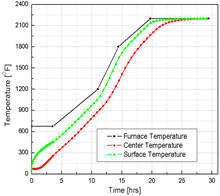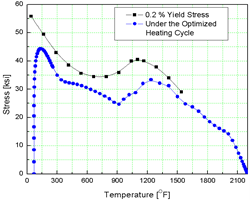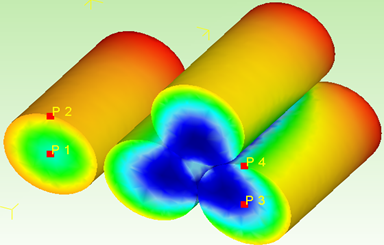Thermal Process Modeling to Save Energy
Emerging Technology
Authors: V. Mendoza, J. Gonzalez
Thermal Process Modeling to Save Energy
The heating required during the ingot conversion process — hot rolling, radial forging, and heat treatment — is energy-intensive but critical to the integrity of the workpiece, the final microstructure, and the mechanical properties of the material. To achieve cost and energy efficiency, thermal processes must be optimized to reduce the cycle time while maintaining material integrity and quality.
The thermal schedule for heating workpieces is often determined by simple rules and experience in industrial production. Thus, a finite element method (FEM) based simulation of heating ingots in heat treatment furnaces is of great importance to thermal optimization. FEM modeling allows for the prediction and control of temperature uniformity — and ultimately microstructure, residual stresses, workpiece properties, and reducing energy consumption.
Temperature gradients and thermal stresses during the heating of large ingots are main topics for investigation, with special reference to the selection of heating schedules for specialty alloys. In many cases, a 1D analytical solution for radial temperature transients is used in conjunction with an elasticity analysis to determine the maximum thermal stresses that would be generated during ingot heating. The temperature gradients and stresses are seen to be strongly dependent on furnace temperature. 2D FEM simulations incorporate end effects and variations of thermal and elastic properties with temperature, enabling accurate prediction of possible cracking and location. All modeling techniques are informative in designing safe and optimum heating schedules.
Figure 1a depicts a sample temperature evolution of an optimized heating schedule, and Figure 1b shows the stress developed at the critical location. FEM calculation allows us to determine optimum heating schedules for ingot integrity as well as heating time and cost.
 |
 |
| Figure 1a: Temperature evolution at two locations. | Figure 1b: Stress evolution at critical location. |
There are situations in which multiple ingots are placed in stacks or separated in a furnace. Because radiation is a primary contributor of heat transfer in ingot heating, the effect of shadowing among ingots must be measured. Full 3D FEM analysis considering view factor is required for an accurate calculation of temperature evolution and stresses. Figure 2 shows an example of temperature distribution in a stack of three ingots and a fourth being shaded by the stack.

Overall, FEM modeling allows Carpenter Technology to select the optimum thermal conditions for material processing. These optimized processes help our manufacturing teams trim costs by reducing material waste, decreasing rework, and shortening cycle times — all while guaranteeing the alloys we produce meet our high quality standards.
